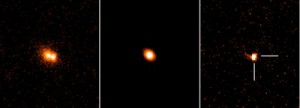Gaia mission discovers its first supernova
Wednesday, 11 March, 2015
Source: European Space Agency (ESA) and Universitat de Barcelona (UB).
Gaia has discovered its first supernova while scanning the sky to measure the positions and movements of stars in our Galaxy. This powerful event, named Gaia14aaa, took place in a distant galaxy some 500 million light-years away, and was revealed via a sudden rise in the galaxy’s brightness between two Gaia observations separated by one month.
Gaia, which was successfully launched on 19 December 2013, started its scientific work last July 25 aiming to scan the entire sky. This means that each of the roughly one billion stars in the final catalogue will be examinated an average of 70 times over the next five years.
This is a Type 1a supernova, which signifies the explosion of a white dwarf locked in a binary system with a companion star.
To confirm the nature of this supernova, the astronomers complemented the Gaia data with more observations from the ground, using the Isaac Newton Telescope (INT) and the robotic Liverpool Telescope on La Palma, in the Canary Islands, Spain. Nadejda Blagorodnova, researcher at the Institute of Astronomy in Cambridge, says that “in the spectrum of this source, we could already see the presence of iron and other elements that are known to be found in supernovas”.
“This is the first supernova in what we expect to be a long series of discoveries with Gaia mission”, says Timo Prusti, scientist who participates in the project that constitutes the maximum exponent of a technology that places Europe in a leading position in the field of astrometry.
